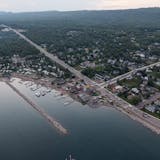One of the most common problems with decks in Minnesota is frost heave. Today I'll explain how this works, why it matters, and what steps can be taken to help prevent frost heave when building a deck.
How Frost Heave Works
When expansive soils freeze and expand, the earth rises. Wikipedia has a nice illustration of how this works, shown below.
How much can soils heave? It depends. I once lived in a townhouse in Saint Louis Park with a patio that would heave about 4" during the winter; it got so bad that I could barely open my storm door during the winter.
Damage Caused by Frost Heave
Without a doubt, some of the worst frost heave I've come across has been here in Maple Grove. The photo below shows a Maple Grove deck that we recently inspected in the middle of an April snow storm. The right side had obviously heaved several inches. Click on the photo for a larger view.
The deck shown below had severe frost heave in the middle and against the house, and had to be completely torn down and rebuilt because the deck was so severely heaved in the middle.
Here's one more photo showing major frost heave at a deck.
How Deck Footings Heave
When a deck is attached to a building, the part of the deck that gets supported by the earth needs to have proper frost footings. The most common deck footing is basically a big chunk of concrete poured in to a hole in the earth. The goal is to have this chunk of concrete go deep enough in to the ground so that the bottom rests on soils that never freeze, which should prevent the soils from pushing the footing up.
When deck footings aren't poured deep enough, decks can heave. Sandy, well drained soils aren't particular susceptible to frost heave, while soils with higher clay content are prone to frost heave. This is why it's so important for deck footings to extend down below the frost line.


